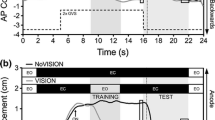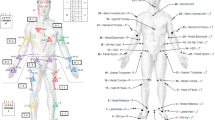Abstract
Our recent work demonstrated that vision can recalibrate the vestibular signal used to re-establish equilibrium following a platform perturbation. Here, we investigate whether vision provided during a platform perturbation can recalibrate the use of vestibular reafference during the dynamic phase of the perturbation response. Dynamic postural responses were examined during a series of five forward perturbations to the body, while galvanic vestibular stimulation (GVS) selectively altered vestibular feedback and LCD occlusion spectacles controlled visual availability. Responses with and without vision were compared. The presence of GVS caused 1.78 ± 0.19 cm of medio-lateral (ML) body motion toward the anode during the initial 3 s of the dynamic postural response across perturbations. This dynamic ML response was attenuated across perturbations 1–3 independent of visual availability, resulting in a significant reduction of ML center of mass and pressure deviations (p < 0.01, ƞ2 = 0.27). That is, the vestibular influence on the ML perturbation response could be altered but vision was not necessary for this adaptation. After removing GVS, the ML response component reversed in direction toward the cathode with a magnitude that was not significantly different to the amount of response attenuation seen when GVS was present (− 0.95 ± 0.19 cm; p = 0.99, ƞ2 = 0.00). This suggested that the use of a GVS-altered vestibular signal during dynamic perturbation responses could be recalibrated, but that visual feedback was likely not responsible. Alternative mechanisms to explain the recalibration process are discussed.





Similar content being viewed by others
References
Abdi H (2006) Bonferonni and Šidák corrections for multiple comparisons. Encycl Meas Stat 3:103–107
Allum JHJ, Carpenter MG, Honegger F et al (2002) Age-dependent variations in the directional sensitivity of balance corrections and compensatory arm movements in man. J Physiol 542:643–663
Bent LR, McFadyen BJ, Merkley VF et al (2000) Magnitude effects of galvanic vestibular stimulation on the trajectory of human gait. Neurosci Lett 279:157–160
Berencsi A, Ishihara M, Imanaka K (2005) The functional role of central and peripheral vision in the control of posture. Hum Mov Sci 24:689–709. https://doi.org/10.1016/j.humov.2005.10.014
Carlsen AN, Kennedy PM, Anderson KG et al (2005) Identifying visual–vestibular contributions during target-directed locomotion. Neurosci Lett 384:217–221. https://doi.org/10.1016/j.neulet.2005.04.071
Creath R, Kiemel T, Horak F, Jeka JJ (2002) Limited control strategies with the loss of vestibular function. Exp Brain Res 145:323–333. https://doi.org/10.1007/s00221-002-1110-0
Day BL, Cole J (2002) Vestibular-evoked postural responses in the absence of somatosensory information. Brain 125:2081–2088
Day BL, Guerraz M (2007) Feedforward versus feedback modulation of human vestibular-evoked balance responses by visual self-motion information. J Physiol 582:153–161. https://doi.org/10.1113/jphysiol.2007.132092
Ernst MO, Di Luca M (2011) Multisensory perception: from integration to remapping. In: Trommershäuser J, Kording K, Landy MS (eds) Sensory cue integration. Oxford University Press, Oxford, UK, pp 224–250
Héroux ME, Law TCY, Fitzpatrick RC, Blouin J-S (2015) Cross-modal calibration of vestibular afference for human balance. PLoS ONE 10:e0124532. https://doi.org/10.1371/journal.pone.0124532.g005
Horak FB, Hlavacka F (2002) Vestibular stimulation affects medium latency postural muscle responses. Exp Brain Res 144:95–102. https://doi.org/10.1007/s00221-002-1041-9
Inglis JT, Shupert CL, Hlavacka F, Horak FB (1995) Effect of galvanic vestibular stimulation on human postural responses during support surface translations. J Neurophysiol 73:896–901
Jilk D, Safavynia SA, Ting LH (2013) Contribution of vision to postural behaviors during continuous support-surface translations. Exp Brain Res 232:169–180. https://doi.org/10.1007/s00221-013-3729-4
Keshner EA, Allum JH, Pfaltz CR (1987) Postural coactivation and adaptation in the sway stabilizing responses of normals and patients with bilateral vestibular deficit. Exp Brain Res 69:77–92
Lacour M, Barthelemy J, Borel L et al (1997) Sensory strategies in human postural control before and after unilateral vestibular neurotomy. Exp Brain Res 115:300–310
Maaswinkel E, Veeger HEJ, Dieen JH (2013) Interactions of touch feedback with muscle vibration and galvanic vestibular stimulation in the control of trunk posture. Gait Posture 39(2):745–749. https://doi.org/10.1016/j.gaitpost.2013.10.011
Maurer C, Mergner T, Bolha B, Hlavacka F (2000) Vestibular, visual, and somatosensory contributions to human control of upright stance. Neurosci Lett 281:99–102
Mian OS, Day BL (2014) Violation of the craniocentricity principle for vestibularly evoked balance responses under conditions of anisotropic stability. J Neurosci 34:7696–7703. https://doi.org/10.1523/JNEUROSCI.0733-14.2014
Nashner L (1972) Vestibular postural control model. Kybernetik 10:106–110
Peterka RJ (2002) Sensorimotor integration in human postural control. J Neurophysiol 88:1097–1118. https://doi.org/10.1152/jn.00605.2001
Rosengren S (2002) Differential effect of current rise time on short and medium latency vestibulospinal reflexes. Clin Neurophysiol 113(8):1265–1272
Smetanin B, Popov K (1990) Changes in vestibular postural response determined by information content of visual feedback. Neurophysiology 22(1):66–72
Soechting JF, Berthoz A (1979) Dynamic role of vision in the control of posture in man. Exp Brain Res 36:551–561
St George RJ, Day BL, Fitzpatrick RC (2011) Adaptation of vestibular signals for self-motion perception. J Physiol 589:843–853. https://doi.org/10.1113/jphysiol.2010.197053
Sturnieks DL, Bent L, Fitzpatrick RC (2005) Vestibular input is calibrated to a visual reference frame during walking. Gait Posture 21:S30–S31. https://doi.org/10.1016/S0966-6362(05)80104-3
Toth AJ, Harris LR, Zettel J, Bent LR (2017) Vision can recalibrate the vestibular reafference signal used to re-establish postural equilibrium following a platform perturbation. Exp Brain Res 235(2):407–414. https://doi.org/10.1007/s00221-016-4801-7
Winter DA, Prince F, Frank JS et al (1996) Unified theory regarding A/P and M/L balance in quiet stance. J Neurophysiol 75:2334–2343
Wright WG, Creem-Regehr SH, Warren WH et al (2014) Sensorimotor recalibration in virtual environments. Virtual reality technologies for health and clinical applications. Springer, New York, pp 71–94
Acknowledgements
This work was supported by the Natural Science and Engineering Research Council of Canada.
Author information
Authors and Affiliations
Corresponding author
Additional information
Publisher's Note
Springer Nature remains neutral with regard to jurisdictional claims in published maps and institutional affiliations.
Rights and permissions
About this article
Cite this article
Toth, A.J., Harris, L.R. & Bent, L.R. Visual feedback is not necessary for recalibrating the vestibular contribution to the dynamic phase of a perturbation recovery response. Exp Brain Res 237, 2185–2196 (2019). https://doi.org/10.1007/s00221-019-05571-6
Received:
Accepted:
Published:
Issue Date:
DOI: https://doi.org/10.1007/s00221-019-05571-6




